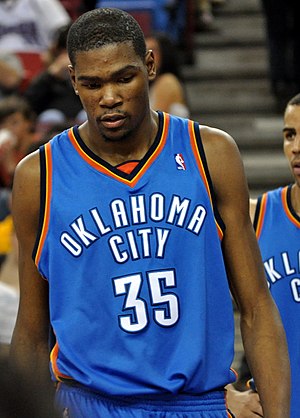 With due respect to Charles Dickens, the NBA has provided us with it’s own version of “A Tale Of Two Cities”. Better yet, let’s call this story “A Tale Of Three Cities”. At this point, I’ll bet you’re thinking of Cleveland and Miami – those involved in the Continuing Saga of LeBron James.
With due respect to Charles Dickens, the NBA has provided us with it’s own version of “A Tale Of Two Cities”. Better yet, let’s call this story “A Tale Of Three Cities”. At this point, I’ll bet you’re thinking of Cleveland and Miami – those involved in the Continuing Saga of LeBron James. But what is the third city? Oklahoma City. Yes, Oklahoma City.
Why Oklahoma City, you might ask? It provides a contrast, a touch of drama if you will, a fine protagonist in this tale of money, hype, and out-of-this-galaxy egos.
For those who have recently been devoid of any media whatsoever (because it would take complete and total isolation on a desert island to have avoided this story), King James – otherwise known as LeBron James – has left the building. And his current throne. Well, he’s left the Quicken Loans Arena in Cleveland at least. LeBron, in search of the promised land (and his first NBA championship ring) has headed to Miami. Along the way, he joined Chris Bosh and Dwayne Wade to create a sort of hypothetical-on-paper “Dream Team”. James and Chris Bosh signed six year contracts, each worth $110.1 million, and Dwayne Wade re-signed for $107.5 million for 6 years. That’s is a whole lot of money being spent for a net total of one championship ring (for Wade) in the 7 years since they were all drafted in 2003.
With Wade and Bosh and James, the Heat will be so tight on the salary cap that they will have to start the janitor and hot dog vendor in the other two starting positions. And one can only guess who is coming off the bench at this point. Beyond that, it will be interesting to see if the egos all fit on the court at the same time.
This is far beyond being a story of money or championships. All you have to do is look to Oklahoma City for the tale of, well, another city – and another player – that puts this all in perspective: Kevin Durant.
 The first half saw more yellow cards than shots on goal. And the game went into extra time, tied 0 – 0. It certainly wasn’t a particularly memorable game. Spain had many great offensive opportunities, most of which were nullified by the inability to pass to the open man (or hit the broad side of a barn with a free kick). Further drama ensued as the Dutch team played the better part of 15 minutes with 10 players after a red card ejection.
The first half saw more yellow cards than shots on goal. And the game went into extra time, tied 0 – 0. It certainly wasn’t a particularly memorable game. Spain had many great offensive opportunities, most of which were nullified by the inability to pass to the open man (or hit the broad side of a barn with a free kick). Further drama ensued as the Dutch team played the better part of 15 minutes with 10 players after a red card ejection.
But at 116 minutes into the game, Andres Iniesta secured his place in Spanish sporting history to give La Furia Roja the win. This was their first World Cup championship, putting them in an elite group of just eight countries that have won a World Cup.
The World Cup is always a spectacle. And it certainly has a way of keeping the world’s attention for a full month.
For all of the beautiful, elegant play, we were also witness to some ridiculous (though elegant) dives and flops from the players. And it was intriguing to see that soccer, on the international level, has it’s share of over-rated players and teams. In that way, it is very similar to professional football on this side of the Atlantic. Case in point: none other than Wayne Rooney and England’s soccer team. At one point in time, they were amongst the favorites to win the World Cup. Rooney was considered one of the primary scorers for England. After 4 matches, what were his statistics? Zero goals and zero assists. And once again, England was over-hyped. Of course, we’ve never witnessed any NFL team being over-hyped, have we?
But wait, there’s more.
 In Part I, I discussed the issues of quality and value in the health care system (in general) and in physical therapy (specifically). Let me expand on that a bit, and then provide an innovative solution to the problems at hand.
In Part I, I discussed the issues of quality and value in the health care system (in general) and in physical therapy (specifically). Let me expand on that a bit, and then provide an innovative solution to the problems at hand.A typical episode of care, in the current paradigm of what is “acceptable care” (note how I did not say “evidence-based care”) is 8 to 10 visits. As I mentioned earlier, this is considered by many to be “great care” and is even advertised as such. These same 8 to 10 visits are costing the patient, on average, anywhere from $64 to $80 per visit, with a total of $512 to $800 out-of-pocket for any given episode of care. This investment may not provide much value-added benefit nor quality, especially if evidence- and science-based strategies have not been implemented in competent self care strategies. Sadly, the disconnect between quality and value has become the accepted standard amongst clinicians and patients – for all the reasons that I outlined in Part I.
Add to this the fact that for every $10 spent on health care, $9 are spent on overhead. Yes, just $1 is spent on actual care, and even that is being lost in the quality/value debacle. But we also know that for every year of education, health care costs drop. So having people better educated in the process of their care makes good sense economically and culturally.
Seven years ago, my clinical practice moved from an insurance-based model to an out-of-network fee for service model. But what I have found over the years is that patients are so driven by “what their insurance covers or pays for” or “who is in or out of network”, that they fail to fully comprehend and consider the issues of quality and value.
A fee for service model can provide an out-of-pocket cost saving, though conflicting value systems remain. Innovation can provide quality, outcome, value, and cost-efficiency, but something radically different will be required to transform our current models. Let’s examine how a fee for mentorship model provides a value proposition that is revolutionary in how we view health care, physical therapy, and health in general.
 Health care is in dire need of transformation. The system as we know it has been built on a foundation of principles that have conflicting values. Whether it’s the reimbursement models or the practice patterns, or both, the concepts of “quality” and “value” have been lost in the mix. What has become the accepted standard of care and delivery has become outdated, and in the midst of it, the patient – the driver of all of this – has been forgotten.
Health care is in dire need of transformation. The system as we know it has been built on a foundation of principles that have conflicting values. Whether it’s the reimbursement models or the practice patterns, or both, the concepts of “quality” and “value” have been lost in the mix. What has become the accepted standard of care and delivery has become outdated, and in the midst of it, the patient – the driver of all of this – has been forgotten.
In any other realm, we look to quality and value as two key elements of an exceptional customer experience. A free and open marketplace fosters this. Consumers critically examine cost, quality of service, and results in their decision-making process for just about everything – cars, homes, education, you name it. Except health care.
Patients have learned to accept the gross failures and inadequacies of the health care system. Are patients satisfied with their care? Sure. But are their expectations of this “accepted standard” really at a high enough level? Or are they satisfied with something less simply because they have been told that that is the accepted standard?
This becomes all the more apparent in the world of physical therapy. When there are clinicians proclaiming that “first class service and results” create “the top physical therapy clinic for patient satisfaction” – and then stating that the “average length of stay is 10 visits – guaranteed” – I shake my head in disbelief. When 10 visits per course of care is considered “great care”, I have to wonder about what has become the accepted standard these days.
And there is plenty of finger-pointing by the clinicians at the insurance companies. It’s their fault for such low reimbursement rates, right? On the surface, there are many instances in which the finger-pointing may be well-deserved. But when you point a finger, as they say, four point back at you. The clinicians are as much to blame as anyone, and much of that has to do with a simple lack of innovation at a far deeper, systemic level. It starts with the clinician, their product, and their means of delivery.
Transformation requires a deeper level of understanding of the systemic problems, so let’s start there first.
 If you are a sports fan, and more specifically a fan of pro basketball, football, or baseball, you are probably acutely aware of draft day. If you have a favorite team, you’ve probably got your fingers crossed that your team is going to draft a player that fills a few holes, or becomes a franchise player, or at least puts more fans in the seats and brings some much-needed excitement to game day.
If you are a sports fan, and more specifically a fan of pro basketball, football, or baseball, you are probably acutely aware of draft day. If you have a favorite team, you’ve probably got your fingers crossed that your team is going to draft a player that fills a few holes, or becomes a franchise player, or at least puts more fans in the seats and brings some much-needed excitement to game day. In the midst of all of this draft day hoopla, we have the hopes and dreams of countless collegiate athletes. They have toiled at their sport for years, and now they find out if they are going to be pursuing a career in pro sports. I guess that makes perfect sense for a college senior. It is a natural progression – go to school, play your sport while doing so, get a degree, go on to play your sport professionally, and fall back on the aforementioned degree if anything happens to the dream in the process.
Now we have a new phenomenon to deal with – the underclassman declaring for the draft. And with that, the bastion of higher education has become nothing more than a farm team for pro sports.
Is it appropriate for a college freshman to enter the draft? And perhaps the bigger question is – should the professional sports leagues allow it in the first place?
 It’s not easy being green these days. Kermit the frog had it right all the way back in 1969. “Being green” takes on some new meaning over the past couple of weeks. So for this episode of Rhubarb Ruminations, we’ll explore how “being green” is more than just an environmental call-to-arms.
It’s not easy being green these days. Kermit the frog had it right all the way back in 1969. “Being green” takes on some new meaning over the past couple of weeks. So for this episode of Rhubarb Ruminations, we’ll explore how “being green” is more than just an environmental call-to-arms.
#1: First, let’s start with the environmental side of the coin, especially with the growing BP oil spill in the Gulf of Mexico. It would seem to me that if I am going to drill a well that is one mile below the ocean’s surface, that I should also have the technology and plans in place to remedy a problem should bad things happen. Because we know that somewhere along the line, somehow, bad things happen. It’s inevitable. But even if we can get beyond the amazing lack of planning, we are still left with the anger inherent to people losing their livelihood. And in the bigger picture, it’s just another wake-up call to realize that we’re doing a fine job of systematically killing the planet (why is it that REM is playing in my mind right now?).
But hold on a second. I understand the anger involved. And I, for one, sit flabbergasted at the levels of stupidity we’ve witnessed as this problem unfolds (or comes bubbling to the surface, if you prefer). However, I don’t see how Rep. Joseph Cao can suggest that BP America president Lamar McKay should commit hara-kiri because of the spill.
 Direct access to Physical Therapy still faces many barriers in the United States. Many of these barriers are simply not in the best interest of the patient, in that the current regulatory practice of a "referral" process to get to the appropriate provider creates greater costs for the patient and the right to immediate and effective care, a fact that patients simply do not understand.
Direct access to Physical Therapy still faces many barriers in the United States. Many of these barriers are simply not in the best interest of the patient, in that the current regulatory practice of a "referral" process to get to the appropriate provider creates greater costs for the patient and the right to immediate and effective care, a fact that patients simply do not understand. As a physical therapist in Texas, I have watched the continued struggle with direct access to Physical Therapy. Texans can see a Physical Therapist for an initial evaluation, but cannot subsequently receive treatment without a physician referral. As a McKenzie practitioner, not having direct access is an enormous barrier to caring for our patients. With an assessment process that naturally shifts to treatment, we are faced with a dilemma. If the assessment reveals a directional preference, then instead of simply taking the next step and educating the patient regarding the importance of this, we must then interject "you need to see a physician for a referral."
In an era of “evidence”, there is plenty to indicate that direct access to Physical Therapy would increase a patient’s access to appropriate and necessary health care, decrease their cost of care and restore the patient’s right to choose.
In order for our health care system to move forward, it is time for all of us to put our best foot forward and foster a medical system that is truly patient-centered.
 "Running Injuries: Etiology And Recovery- Based Treatment" (co-author Bridget Clark, PT) appears in the third edition and fourth editions of "Clinical Orthopaedic Rehabilitation: A Team Approach" by Charles Giangarra, MD and Robert C. Manske, PT.
"Running Injuries: Etiology And Recovery- Based Treatment" (co-author Bridget Clark, PT) appears in the third edition and fourth editions of "Clinical Orthopaedic Rehabilitation: A Team Approach" by Charles Giangarra, MD and Robert C. Manske, PT.
 Allan Besselink, PT, DPT, Ph.D., Dip.MDT has a unique voice in the world of sports, education, and health care. Read more about Allan here.
Allan Besselink, PT, DPT, Ph.D., Dip.MDT has a unique voice in the world of sports, education, and health care. Read more about Allan here.
 Top 5 finalist in three categories: "Best Overall Blog", "Best PT Blog" and "Best Advocacy Blog".
Top 5 finalist in three categories: "Best Overall Blog", "Best PT Blog" and "Best Advocacy Blog".